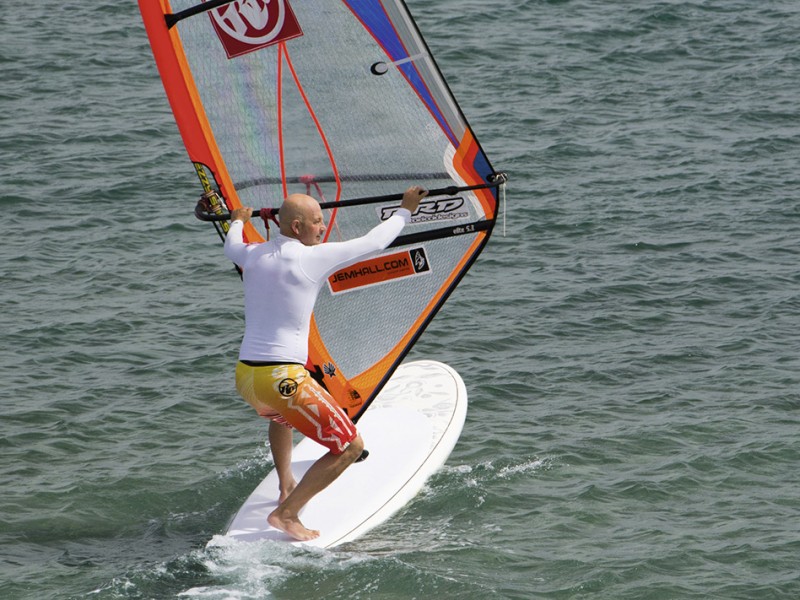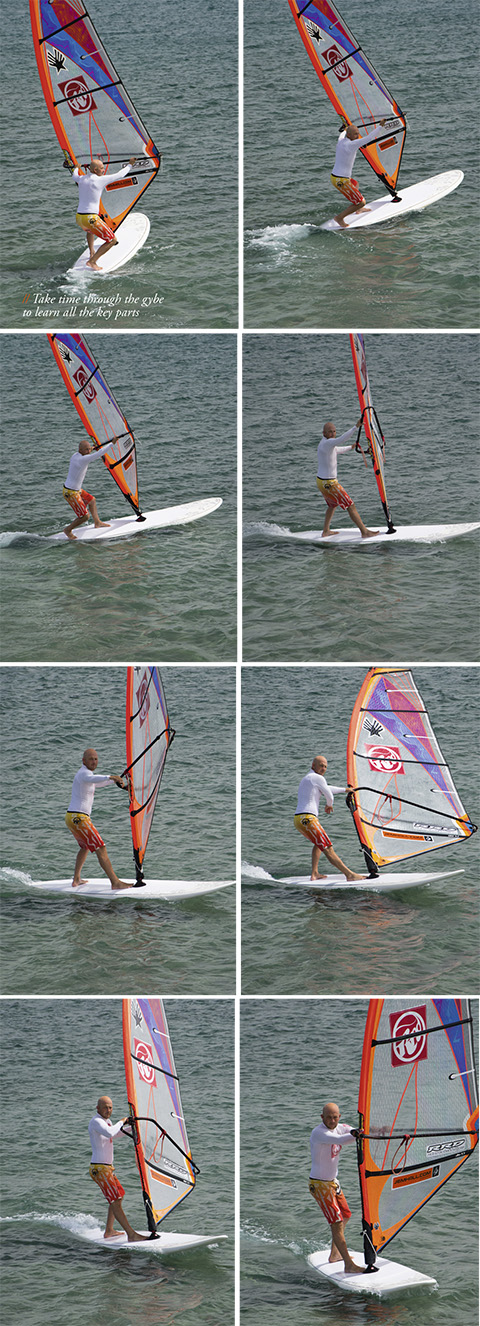JEM HALL MOVE ON UP - SKILLS AND DRILLS

JEM HALL MOVE ON UP – SKILLS AND DRILLS
Looks like summer is here, so I hope you’ve been getting out on the water and had a few sessions under your belt? So, coach would like to know how are the cracking tacks and Holy Trinity going?
Words JEM HALL // Photos NicK Jones
(This feature originally appeared in the July 2014 issue of Windsurf Magazine. To read more features like this first, Print and Digital subscriptions are available. Prices include delivery globally for 10 x issues a year!)
I really hope they are progressing well, through practice AND visualization, and if you want to move these forward then I will reveal a top secret you, shhhhh get on out there in light winds … shock horror! I can hear you say ‘I’m only going out if it is windy,’ or ‘my kit is too small.’
TIME ON WATER (T.O.W.)
Well I can reliably inform you that quite often the most learning and improvement on my coaching holidays comes in the lighter wind sessions and, often, the high wind moves like tacks, gybes and duck gybes are cracked after nailing these moves’ core skills down tight in less wind. As I have a lot of returners on my coaching hols, I can safely say that the ones who improve the most year-on-year are those that hone their ‘Skills and Drills’ in lighter airs AND on bigger kit, these people are all pro active learners and motivated to improve.
This month we look at what these drills and skills are and what the main tips and guidelines are for successful performance. I will focus on sharpening these skills on a WindSUP (Windsurfable Stand Up Paddleboard) this month and then next month on a floaty freemove/ freeride board. The WindSUPs are here to help us and our sport – and the most popular boards bought after a clinic, either on flat water or waves, are W’SUPs or floatier planing boards so as to have the opportunity to get more EFFECTIVE Time On The Water. Again, if you want to improve, you must choose to take actions to do exactly this, so, what actions could you take?
MOVES THAT MATTER
When I’m coaching in a light wind session I ask my rippers to grab a bigger board / W’SUP and a smaller rig, whilst some of our other more ‘learned’ fellows are on huge sails and smaller boards and sporting their speedos and high wetsuit boots and are generally going nowhere fast. This windsurfing lark is challenging enough, so let’s make it easy and go out and get back to our beginner and the sport’s founding roots and use bigger boards and smaller sails to have the time and control to learn the ‘moves that matter.’ Again, all these skills and a huge amount more are covered in full in my DVD ‘Beginner to Winner’.
STANCE:
The first skill is all about stance and how to get the best speed out of the board. Therefore, lets get all touchy feely and find the best place to put your hands and feet, which are mainly closer together and where it all feels balanced. ‘Don’t think, feel’ the kit is giving you feedback and it is saying ‘don’t over sheet me’, or, ‘stand further forward, and point your front foot forward to make you face forward’ (a huge tip for early planing in stronger winds!)
Drills for Stance:
• One of my favourite skills, in all winds, is to sail one-handed. Drop your backhand and you will control the power more through your hips and feel just how important it is to steer the board through your feet and pull down on the boom – do it!
• Sail with your front hand off will see a similar skill development to the above and also help you to appreciate where the power point in the sail is. Both skills are also quite physical so are great for your water fitness!
• Lift your front leg. This will help you position your back foot better, both fore and aft (pivot) and side-to-side (tilt). Just do it.
• Kneel down over your front leg or drag your front leg in the water. This gets you pulling down on the boom and bending your back leg heaps in order to really add dynamism all over – especially in learning and improving your beach and waterstarts!
• Now try one hand and one leg. Feel, enjoy and experiment.
TRANSITIONS
Practice makes permanent and, as they say, it takes 1000 reps to make a skill more automatic and locked into your motor memory. Therefore, a light-wind session of 40 mins could see you banging out 20 – 40 tacks and gybes, which has got to be good for staying dryer in higher winds and also for your fitness and getting your hands tougher?
Oh yes, you should please be doing your force 1 – 3 skills and drills with no harness on to get a feel for the trim and to develop your fitness and unhooked skills.
We covered tacks last month and so please refresh by reading this again. Now you are in lighter winds and on a big, open lovely EVA deck, please work on really using your legs and really moving your hips and feet dynamically.
Top Tack Tips: Feet and hands are narrower on the way in and wider on the way out. So get that back foot down the board on your exit please so you have the opportunity to steer (scissor legs) aggressively.
![1]()
![2]()
![3]()
GYBE TALKING:
I can safely say that, unless people have cracked the light wind gybe (fundamentals gybe) and its all important stages of a clear beginning, middle and (clew-first) exit, then it will be very tough to master the carve gybe in planing conditions. My coaching holidays on flat water without a few light wind sessions see a bit less progress than the trips that are howling all week. So, no, seven days of Force 6 will not make you a gybing legend unless you’re already competent in this area.
This is not a comprehensive guide to the fundamentals gybe, as we’re all embracing our touchy-feely skills, so I’ll give you the basic tips:
• Prepare early with wide hands and feet
• Scissor the board downwind
• Exaggerate, get low and have your back hand at the end of the boom
• Think ‘rig out and hips in’ as you look out the turn, at the clew or back hand
• Switch your feet, front heel to back toe and then step forward
• Sail clew-first out on a broad reach (45 degrees to the wind) and be very very good at this
• Slide your mast hand down and rotate the rig and take your time
• Keep looking forward and take the rig through a big circle
• Sweep the rig forward and across and get low to take the power
A great combo drill here is to do Circles, where you gybe one way and then sail 3 board lengths and then tack the other way and after 10 rotations you then reverse the rotation, i.e., tack and gybe the other way. Or, you can do The Box: sail and tack upwind 200 metres – and then gybe back downwind.
REE YOUR STYLE
Light winds are all about having fun, trying new stuff and being present in the moment. I often, after 30 minutes of light wind coaching, ask my clinic rippers “what drills have we just done and now please name 20 more we could do?” Why? This gets them refreshing their minds about what they can practice and so puts them in the mindset of a proactive learner and thereby boosts their ability to self coach and set targets – both musts if you wish to improve AND have fun, all whilst becoming a learning machine!
So, before you read on, please have a think and write down on paper – or on your phone – 10 more light-wind moves you would try on the right kit and in the right place …
“ Light winds are all about having fun, trying new stuff and being present in the moment ”
![4]()
![5]()
![6]()
SKILL BUILDERS
OK, I’ll now add to your list and also see how many we are sharing on our lists, so, in addition to the above skills, you could perform:
OK, I’ll now add to your list and also see how many we are sharing on our lists, so, in addition to the above skills, you could perform:
• Light-wind beach starts, fin-first beach starts, clew-first ones too
• Ducking the sail and then sail clew first, then rotate the rig. (Called a sail 360)
• Ducking the sail and then gybe. This is called a, surprise surprise, duck gybe
• Front-to-sail: build skills for learning to heli tack
• Duck tacks, de rigueur for all you budding high-wind stylers
• Body and sail 360s: remember to not think and just ‘feel’
• Boomerangs / floaters

This is not exhaustive and the list is endless. All you need is to focus, believe and enjoy while employing a large amount of perspiration and perseverance that will defo stand you in good stead for all the moves you want in high winds.
Go on and get out there and enjoy the W’SUP action, it’s funner than you think.
RRD boards, wetsuits, softwear, Ezzy sails and Pro Sport Sunblock sponsor Jem Hall. Get him live and direct on one of his highly-acclaimed coaching holidays, but be quick as they are selling out – check out his fab new site www.jemhall.com for details. You can also follow him on Twitter / Facebook.
The post JEM HALL MOVE ON UP – SKILLS AND DRILLS appeared first on Windsurf Magazine.





